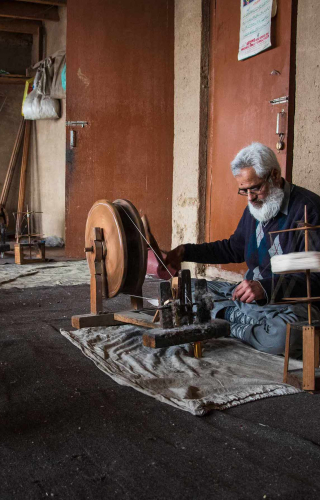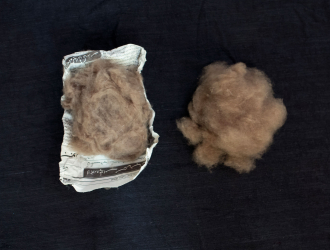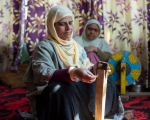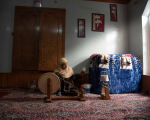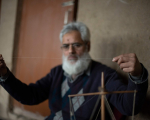Growing up in Kashmir, the first time I saw a pashmina fabric was at an exhibition hall; I was in the fifth grade then, and this fine piece of craftsmanship got etched in my memory. As part of the Frames Photography Grant, I got the opportunity to find out more about this textile tradition and the process that goes into its making.
At 8 in the morning, on a cold March morning, I hired a taxi from my hometown Anantnag and headed to Srinagar. After an hour and 15-minute journey, I finally reached Downtown Srinagar. There, I met my guide who escorted me to some local workshops. Talking to him, I discovered that Sultan Zain-ul-Abidin (r. 1418–1419 and 1420–1470 CE) was a major patron of pashmina and credited with establishing the industry in Kashmir by inviting craftsmen from Turkestan, in Central Asia, to settle in Kashmir. However, there is also an alternate theory that the making of pashima was already popular much earlier, probably introduced by the Sufi scholar Mir Sayyid Ali Hamadani (1314–1384 CE), who discovered fine goat wool during a visit to Ladakh and brought back samples to show Sultan Qutubuddin (r. 1374–89 CE). Impressed by the softness and warmth of the wool, the sultan invited 700 families of craftsmen from Persia, who introduced carpet weaving in Kashmir. Since then, this art has been passed down generations of weaver families.
The pashmina shawl was introduced to western Europe when Napoleon’s campaign in Egypt sent a sample to Paris. The shawl’s arrival created an immediate sensation within Parisian high society. Empress Josephine (1763–1814)—regarded as the first modern fashion icon— collected hundreds of pashmina shawls throughout her life. To maintain regular supply, Napoleon put together plans to manufacture the product in France itself. In 1799, William-Louis Ternaux, the leading woollens manufacturer in France under Napoleon’s rule, began to produce imitation shawls at his factory in Reims using the wool of Spanish merino sheep. Ever since, pashmina has been treasured in Western markets, popularly known as cashmere.
Pashmina is derived from the word pashm (Persian for wool); it is made from the fine, soft undercoat harvested from a species of goat native to the Ladakh region, locally called Changthangi/Changra (Capra hircus). The Changpa nomads collect the raw wool during spring, when the goats shed their undercoat. The goat is not sheared, but wool collected by brushing, especially the neck area. At this stage, the wool is naturally mixed with much coarser outer coating of hair called guard hair. The fine undergrowth is further de-haired and separated from the guard hair. Next, it is cleaned to remove impurities and odour. The fine wool is also treated with rice water starch to give strength to the delicate fibres. Middlemen buy the raw wool from markets in Leh and trade them in Srinagar, where they are sold to pashmina weavers. The Kashmir Valley, especially Srinagar, Budgam and Ganderbal, is famous for the pashmina shawl industry.
The skill of weaving high-quality pashima shawls has been taught and passed down generations in weaver families who continue to ply the craft even today. Every member of the family has a distinct task assigned. The raw wool is spun into yarn using a spinning wheel. This involves great skill and practice. Then, another round of washing in starch takes place. The natural colour of pashmina wool is white and various shades of brown. If multiple colours are desired, they are dyed accordingly by a rangur (dyer). Next, the weft and warp is prepared for the loom. The yarn is rolled into small bobbins required to make the weft. The warp is made by manually winding the pashmina yarn across four to eight iron rods erected on the ground. Before the warp can be put on the handloom, it has to be dressed by a bharanguror warp-dresser. This process involves stretching and fixing of yarn in the heddles of a saaz (loom). Weaving is done on the large wooden stand locally called thanjoor. The shawl weaver is called wovur and the process is called wonun. While weaving, the thread breaks many times. To join the threads, the weaver rolls the broken ends together and this results in split ends all over the shawl. These protrusions are clipped by a process called purz and the person skilled in this is called a puruzgar. Finally, the edges are finished to make fringes by a process called andkadun and the person who does this is called andgour.
The finishing is mainly of two types—kani work and sozni work. Kani is woven on loom and sozni is needle embroidery work. Kani in Kashmiri language means small wooden sticks or bobbins. A kani pashmina shawl is woven with these kani sticks, otherwise called tujlis, and they require a high level skill to handle. To experience the making of kani, I made my way to Kanihama, a small village on the Srinagar–Gulmarg Road in Budgam district, which is considered the epicentre of kani work. Upon entering the village, I was greeted warmly, and offered tea and bakirkhanis. After having my tea, with a local boy as my guide, I walked through narrow lanes and finally reached the weavers home where I was introduced to some of the craftsmen who explained the weaving process to me.
First, the naqash (pattern drawer) makes a pattern of kani design on graph paper. Kani shawl is woven like a carpet based on coded pattern called talim. The talim consists of a set of symbols denoting various numbers of warp ends, and a second set denoting the different colours the kani sticks have to go over. This coded pattern is prepared by a talim guru based on the design made by the naqash. The twilling of kani incorporates the method known as twofold interlocking. This alludes to the interlocking or joining of each weft string each time it meets one of an alternate shading. The weaving work is finished by embedding the prepared kanis over, and then under pairs of adjacent warp threads. Kani pashmina shawls are woven mostly keeping in mind two weave patterns. These are the full embroidery Jamawar and the outskirt design, Palldar. A complete Jamawar shawl takes around 12 to 24 months to finish. This is why they are usually costlier than any other pashmina shawls in the market. Though a very complicated and laborious process, I was moved by the love Kani weavers have for their craft.
Next morning, I ventured in search of sozni pashmina shawl weavers. Sozni is actually a style of embroidery. Similar to kani weaving, here also a naqash carefully draws the design to be embroidered on a graph paper using geometrical and mathematical techniques. Based on the design prepared by the naqash, a block of walnut wood is carved by a wood carver specialising in shawl designs. Thereafter, the design is transferred onto the shawl by a printing specialist called chapangur. The carved block is dipped in washable ink and stamped on the shawl. The stamped shawl is passed to a master artisan, called tarah-guru, who does sample embroidery and determines what colours are to be used. Another master craftsman, called voste, approves or asks for any changes in the design. Once approved, the shawl is passed to the artisan for completion of the embroidery. Sozni needlework is so fine, it is hard to believe that the design is not woven.
As I was about to complete this marvellous journey, I realised that still photographs don’t do justice to the fine craftsmanship of pashmina weavers; one needs to see them up close to experience the precision and dexterity involved in this craft. Pashmina has been, for centuries, an emblem of Kashmiri culture, and an important means of livelihood for the local artisans. However, as a result of the ever-growing demand for pashmina in the international market, there has been a shift to power looms as it is much cheaper and its production capacity is many times higher than that of a traditional handloom. But a power loom-made pashmina does not capture the essence of the craft. An artisan I interviewed put it more aptly: ‘Kani isn’t only a shawl; it is a piece of art. When you wrap yourself in a pashmina, you are not just draping a piece of cloth, it is the story behind that will grasp you in its warmth.’
Bibliography
Rizvi, Janet, and Monisha Ahmed. Pashmina:The Kashmir Shawl and Beyond. Mumbai: Marg Publications, 2009.
